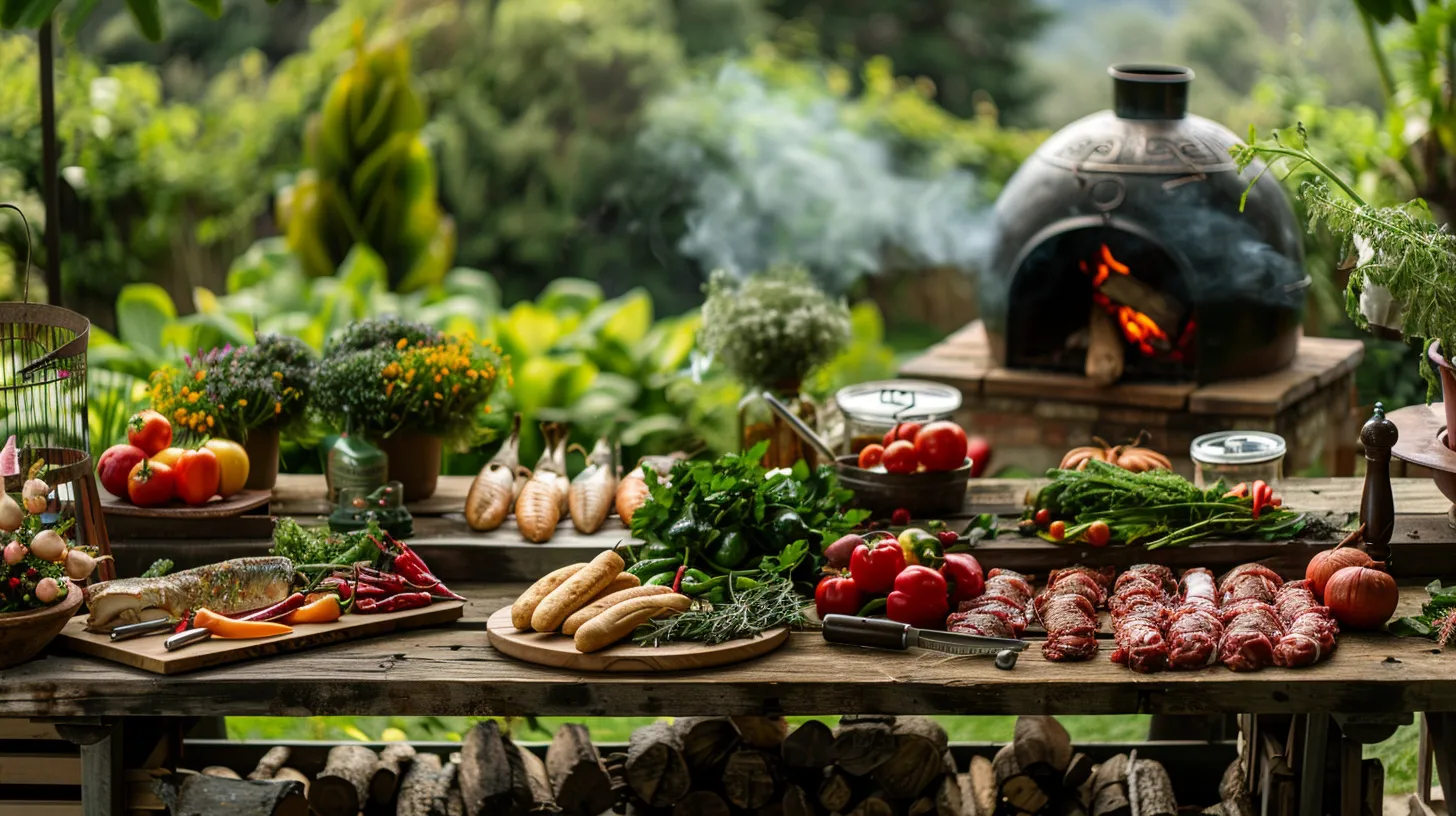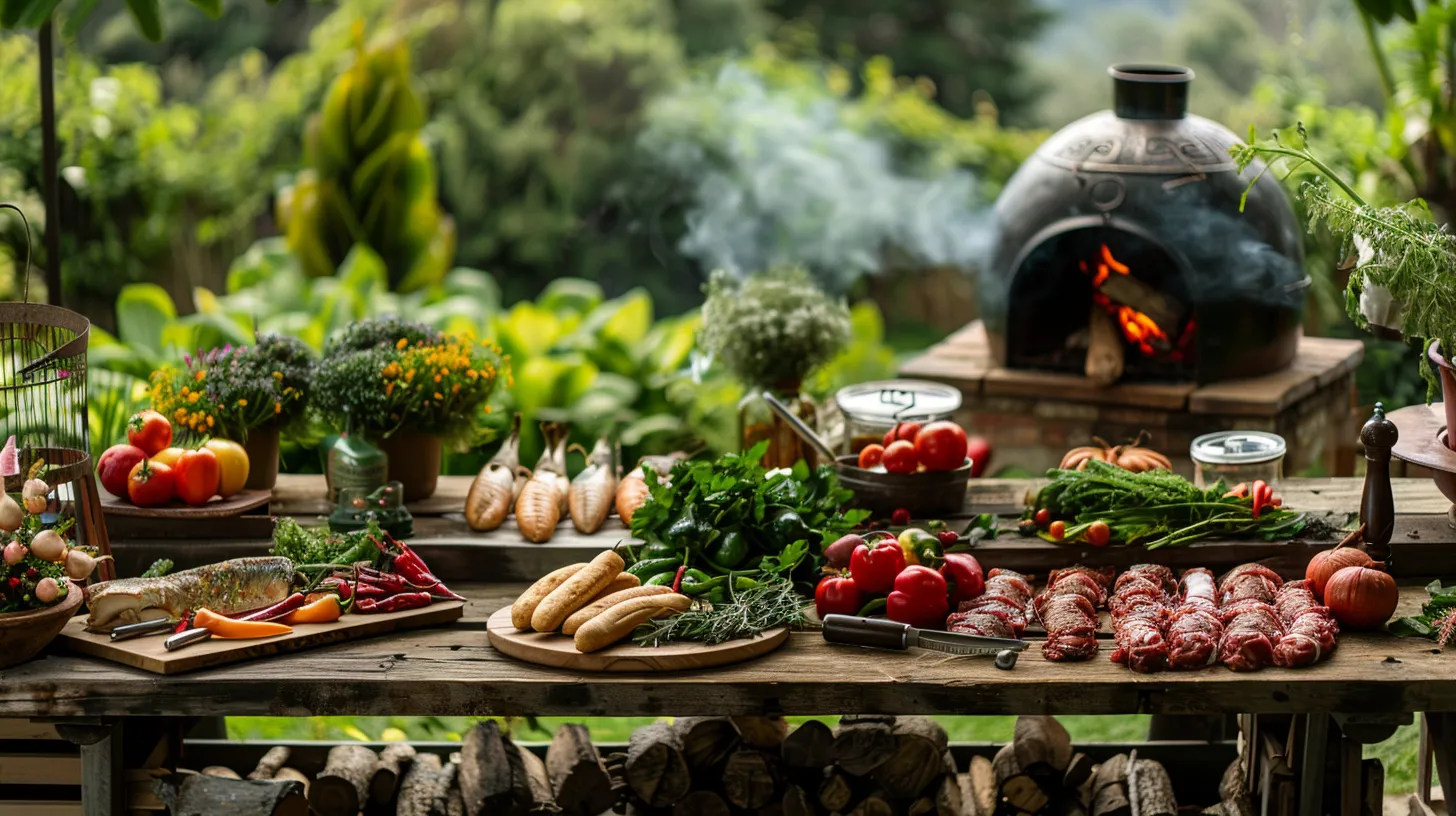Mastering the art of chiminea cooking offers a unique way to enhance your outdoor dining experiences. Begin by selecting the right chiminea, considering materials like clay or cast iron, which affect the cooking dynamics and maintenance. Essential accessories , such as a grill grate and thermometer, are important for temperature control and even cooking. Prepare your chiminea by cleaning and seasoning , making sure it's ready for use. Choose high-quality ingredients and assemble them into foil packs for flavorful, evenly cooked meals. Understand and manage cooking temperatures to guarantee food safety and best taste. Further exploration will uncover additional techniques and tips to perfect your outdoor culinary skills.
Selecting the Right Chiminea

Choosing the right chiminea involves considering material, size, design, fuel type, and additional features to enhance your outdoor cooking experience. Materials like clay, cast iron, and aluminum each offer different benefits; clay provides a traditional aesthetic and good heat distribution , cast iron is highly durable and retains heat well , while aluminum is lightweight and resistant to rust .
The size and design of the chiminea should match the scale and style of your outdoor space. Larger designs are ideal for gatherings where activities like roasting marshmallows or grilling corn on the cob can be enjoyed by many, whereas smaller models fit well in more intimate settings.
Fuel type is another important consideration. Wood-burning chimineas offer a classic experience and are perfect for those who enjoy the scent and sound of crackling logs. For ease of use and cleaner burning, gas or charcoal options are also available, each suitable for cooking varieties of outdoor meals efficiently.
Additionally, some chimineas come equipped with built-in grates or spaces for cooking tools, which expand the culinary possibilities from mere fire gazing to preparing full outdoor meals, making your chiminea not only a centerpiece for warmth but also for gastronomic activity.
Essential Chiminea Accessories

To enhance your chiminea cooking experience, certain accessories are indispensable for both safety and culinary success. A grill grate and a cast iron skillet are fundamental for anyone aiming to explore the full range of dishes that can be prepared with a chiminea. The grill grate allows for direct heat cooking , perfect for searing meats or grilling vegetables. Meanwhile, the versatile cast iron skillet is ideal for everything from sautéing vegetables to baking bread.
Additionally, heat-resistant gloves are essential. They protect your hands when adjusting the firewood or handling the hot cookware, guaranteeing that your cooking process is not only effective but also safe. Chiminea tongs are another critical accessory; they help you manipulate burning logs and safely adjust the position of your cooking tools without risking burns.
To safeguard your chiminea when not in use, a chiminea cover is advisable. It shields the structure from harsh weather conditions , thereby extending its lifespan. Finally, a thermometer gauge is a valuable tool for maintaining the ideal cooking temperature. It ensures your food is cooked precisely, enhancing flavor and ensuring safety. These accessories together create a well-rounded set-up that would work to elevate any chiminea cooking endeavor.
Preparing Your Chiminea

Preparing your chiminea properly is essential for both excellent cooking performance and extending its lifespan. Start by cleaning the chiminea thoroughly to eliminate any debris or residue. This not only guarantees that the flavors of your food remain pure but also prevents potential fire hazards.
Next, focus on the ventilation . Proper airflow is critical, so make sure the chiminea's door or flue is open to facilitate adequate air circulation which aids in controlling the fire's intensity and temperature.
Additionally, it's important to season the chiminea before its first use. Build small, manageable fires initially. This gradual heating process helps to cure the clay, which minimizes the risk of cracking under sudden high temperatures. This step is essential for the longevity of your chiminea.
Before cooking, securely place a grill grate or suitable cooking surface on top of the chiminea. This setup is necessary for stable and safe cooking, ensuring that pots or pans are evenly supported.
Regular maintenance is also key. After each use, remove ash and residues , and keep the chiminea dry to prevent deterioration. These practices ensure that your chiminea remains a reliable tool in your culinary arsenal, ready for each outdoor cooking session .
Choosing Ingredients

Selecting fresh, high-quality ingredients is crucial for enhancing the flavors of your chiminea-cooked meals. When planning your outdoor culinary session, focus on ingredients that can not only withstand the direct heat but also complement the unique cooking method of a chiminea. This includes a wide range of meats which develop a rich, smoky flavor , robust vegetables like bell peppers and onions, and even fruits such as pineapples for a sweet, charred finish .
Choosing a variety of ingredients guarantees each dish is well-balanced and exciting. Incorporate different seasonings to elevate the natural flavors ; herbs such as rosemary and thyme or spices like paprika and garlic powder work beautifully. Opt for ingredients that are easy to prepare and cook, considering the more rustic and often unpredictable outdoor cooking conditions. This simplicity allows for a smoother, more enjoyable cooking experience .
Experimentation is key in chiminea cooking. Try various combinations of meats, vegetables, and fruits to discover what works best for your taste and the specific characteristics of your chiminea. Each ingredient should contribute to creating meals that are not only delicious but also a delight to prepare in the great outdoors.
Foil Pack Assembly Tips

Foil packs, when assembled correctly , offer a versatile and efficient method for chiminea cooking, allowing flavors to meld beautifully within a contained space. To begin, carefully layer your chosen ingredients —vegetables, meats, and seasonings—within the foil. This essential placement is vital as it guarantees each component cooks evenly and absorbs the array of flavors. Use enough foil to fully enclose the ingredients , leaving no gaps.
Sealing the foil is a vital step . Fold the edges tightly to trap moisture and steam inside the pack. This not only prevents any flavorful juices from escaping but also enhances the tenderness and juiciness of the meal. The seal must be secure yet allow a small amount of space for the buildup of steam.
Cooking Techniques Explained

Understanding the various cooking techniques applicable to chiminea use is essential for harnessing its full culinary potential. A chiminea, with its unique structure, lends itself to multiple cooking methods, each suited to different types of dishes and flavors.
Grilling is among the most popular techniques used in chiminea cooking . This method is ideal for quick-cooking meats, vegetables, and even fruits, providing them with a distinctive charred flavor that is hard to replicate with other cooking appliances. The open flame directly exposes the food to high temperatures, creating a crisp exterior while retaining moisture within.
Roasting in a chiminea involves cooking food more slowly and at lower temperatures than grilling . This method is perfect for larger cuts of meat or whole poultry, which benefit from the even heat distribution that the enclosed design of a chiminea provides. The result is tender, succulently cooked meals with a rich, smoky aroma.
Baking and smoking are also feasible with a chiminea. Baking allows for making bread, pizzas, and even pies, utilizing the heat retained within the chiminea's walls. Smoking, on the other hand, is excellent for imparting a deep, wood-infused flavor to meats and fish, a process enhanced by the controlled airflow and sustained low temperatures .
Monitoring Cooking Temperatures
After exploring various cooking techniques in a chiminea, it's essential to focus on how to effectively monitor cooking temperatures to guarantee food safety and achieve desired culinary results. Utilizing a meat thermometer is vital for ensuring that meats reach the safe internal temperatures necessary for consumption; for example, beef should reach at least 145°F and poultry 165°F. Additionally, the use of a grill thermometer is invaluable for maintaining the ideal temperatures required for different cooking methods, such as maintaining 225-250°F for low and slow smoking .
It is also important to check the temperature of food in multiple locations within the cooking chamber. This practice helps in identifying any hot or cold spots and ensures that food is cooked evenly. Given the variations in temperature that can occur in a chiminea, adjusting your cooking technique based on these readings is essential to avoid undercooking or burning the food.
Moreover, understanding and managing the temperature danger zone , which ranges from 40-140°F, is critical. This knowledge helps in preventing bacterial growth on perishable foods during both the cooking process and subsequent storage, thereby ensuring both the safety and quality of the dishes prepared.
Adding Flavors With Cheese
Incorporating different cheeses into your chiminea cooking can greatly enhance the flavor and texture of your dishes. Cheese adds a richness and creaminess that elevates the overall flavor profile of outdoor meals. By selecting from a variety of cheeses such as cheddar, mozzarella, or feta, you can tailor each dish to suit individual taste preferences and create unique culinary experiences.
Melting cheese on top of your dishes not only imparts a gooey, indulgent texture but also complements and enriches the other ingredients. This technique is particularly effective in dishes like foil pack meals , where the cheese can melt into the other elements, binding them together and intensifying the flavors. Similarly, a grilled sandwich becomes a delight with a layer of melted cheese that adds a stretchy texture and deepens the taste.
Experimenting with different types of cheese and their combinations can greatly enhance your outdoor cooking. Each type of cheese brings its own distinct flavor , which can transform a simple recipe into an exciting and memorable meal. Embrace the versatility of cheese in your chiminea cooking to explore new tastes and elevate your outdoor dining experiences .
Safety and Maintenance Tips
To guarantee the longevity and safety of your chiminea, it is essential to conduct regular inspections for any signs of cracks or damage. Identifying and addressing these issues promptly can prevent hazardous situations and make sure your cooking sessions remain safe.
Additionally, incorporating a spark arrestor or screen can greatly reduce the risk of accidental fires by containing embers and sparks. This is especially important in preventing the spread of fire to nearby flammable materials.
Maintaining a clean and clear environment around your chiminea is equally important. Ensure that the area is free from any flammable materials and maintain a safe distance from any structures or overhanging branches to avoid fire hazards. It is also advisable to refrain from using accelerants such as gasoline or lighter fluid. These substances can cause unpredictable flare-ups and increase the risk of injury or property damage.
Regular cleaning is crucial for the best performance of your chiminea. Remove ash and debris to make certain proper airflow and prevent blockages . This not only minimizes excessive smoke but also reduces the risk of chimney fires , making your outdoor cooking experience both enjoyable and safe.










